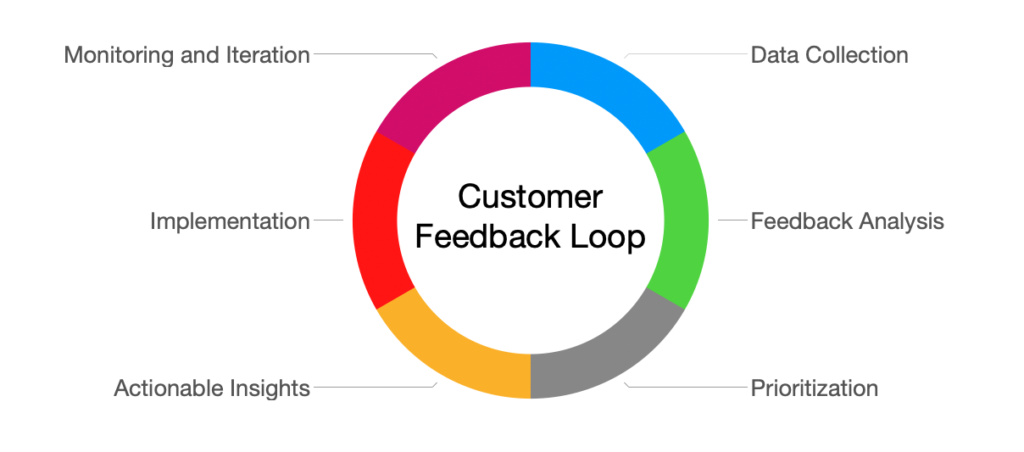
Customer Feedback
“Your customers don’t care about your product; they care about how it solves their problems.”
– Dharmesh Shah
Welcome to Day 18 of the PM series – Product Management in 30 days!
Introduction
Effective product management is a dynamic dance between innovation and customer-centricity. At the heart of this dance is the Customer Feedback Loop—an invaluable tool that empowers product managers to create products that connect with their audience. In this extensive post, we will delve deep into the world of Customer Feedback Loops, exploring their significance, components, strategies, We will also see how they drive product excellence. Let’s get started!
Learning Objectives
- Understand the Importance of Customer Feedback: Define the significance of implementing a customer feedback loop in businesses. Identify the impact of customer satisfaction and loyalty on brand success.
- Analyze Components of a Customer Feedback Loop: Identify and describe the six key components of an effective customer feedback loop. Understand the role of each component in the overall process of continuous improvement.
- Implement Strategies for Building an Effective Feedback Loop: Understand eight strategies for building and maintaining an effective customer feedback loop.
- Measure the Impact of a Feedback Loop: Describe and differentiate between key metrics used to measure the impact of a customer feedback loop (e.g., NPS, CSAT, churn rate, feature adoption, customer retention).
🖐️ Five Reasons – Why Customer Feedback loops are required?
Implementing a customer feedback loop is crucial for businesses to continuously improve their products, services, and overall customer experience. Here are five key reasons why a customer feedback loop is essential:
- Customer Satisfaction and Loyalty: A feedback loop allows businesses to gauge customer satisfaction. Understanding what customers appreciate and addressing their concerns fosters loyalty. Satisfied customers are more likely to stay with a brand, make repeat purchases, and recommend the business to others.
- Identifying Areas for Improvement: Customer feedback provides valuable insights into areas that need improvement. Whether it’s a product feature, service process, or communication strategy, feedback helps businesses pinpoint specific areas that require attention and refinement.
- Innovation and Product Development: Feedback from customers often contains suggestions and insights that can drive innovation and guide product development. Businesses can use this information to enhance existing products, introduce new features, or even develop entirely new offerings that better meet customer needs.
- Enhancing Customer Experience: A feedback loop helps businesses understand the customer journey and identify pain points in the overall experience. By addressing these pain points, businesses can create a more seamless and enjoyable customer experience, leading to higher levels of customer satisfaction.
- Building Customer Relationships: Engaging customers through a feedback loop demonstrates that a business values their opinions. It creates a dialogue between the business and its customers, fostering a sense of community. This communication helps build stronger relationships, and customers appreciate businesses that actively seek their input.
🔄 Understanding the Customer Feedback Loop
The Customer Feedback Loop is a systematic process of continually collecting, analyzing and implementing customer feedback to improve products or services. It’s a vital aspect of the product management lifecycle, helping organizations refine their offerings and enhance customer satisfaction. In the next sections, we will understand the key components required for it.

Six Components of an Effective Customer Feedback Loop
1️⃣ Data Collection: The loop begins with collecting customer feedback through various channels like surveys, reviews, support tickets, and social media. Data collection methods should be diverse, capturing both structured (quantitative) and unstructured (qualitative) feedback.
2️⃣ Feedback Analysis: Once data is collected, it must be carefully analyzed to extract valuable insights. Tools like sentiment analysis, text mining, and data visualization can aid in understanding customer sentiment and pain points.
3️⃣ Prioritization: Product managers must prioritize the feedback based on factors like frequency, impact on user experience, and alignment with the product roadmap. Prioritization ensures that resources are effectively allocated.
4️⃣ Actionable Insights: Translate insights into actionable tasks or features that can be included into the product development cycle. Ensure that feedback is specific, measurable, and tied to clear objectives.
5️⃣ Implementation: Feedback-driven changes are incorporated into the product or service. Agile methodologies can be especially useful in facilitating rapid adjustments.
6️⃣ Monitoring and Iteration: Continuously monitor the impact of changes made based on feedback. Iterate the process to collect new feedback and refine the product further.
🎲 8 Strategies for Building an Effective Customer Feedback Loop
1️⃣ Diverse Feedback Channels: Establish a presence across various channels such as email, social media, in-app feedback forms, and customer support. Offer multiple touchpoints for customers to provide feedback.
2️⃣ Segmentation: Segment your customer base to gain insights into different user groups’ preferences and pain points. Tailor your feedback requests and analysis accordingly.
3️⃣ Real-time Feedback: Implement real-time feedback mechanisms like chatbots or in-app surveys to capture immediate user reactions. Also, respond promptly to feedback to show that you value your customers’ opinions.
4️⃣ Feedback Integration: Integrate feedback data with other systems like CRM and product management tools for a holistic view of customer interactions. This integration streamlines data analysis and decision-making.
5️⃣ Feedback Culture: Foster a company-wide culture that values and encourages feedback from employees and customers. Reward and recognize contributions that lead to actionable feedback.
6️⃣ Feedback Surveys: Design feedback surveys that are concise, engaging, and easy to complete. Ask open-ended questions to encourage detailed responses.
7️⃣ Data Security and Privacy: Ensure customer data is managed with the utmost care and complies with data protection regulations (e.g., GDPR, CCPA).
8️⃣ Closed-Loop Feedback: Close the loop with customers by informing them of their actions based on their feedback. This demonstrates transparency and commitment to improvement.
💥 Measuring the Impact of a Feedback Loop
- Net Promoter Score (NPS): NPS measures customer loyalty and satisfaction by asking how likely customers are to recommend your product or service to others.
- Customer Satisfaction Score (CSAT): CSAT assesses overall customer satisfaction with a service or product by asking them to rate their experience on a scale.
- Churn Rate: The churn rate indicates the percentage of customers who stop using your service or product over a specific period. High churn rates may signal dissatisfaction.
- Feature Adoption: To gauge their acceptance and impact, measure how often customers adopt new features or changes.
- Customer Retention: Track how many customers continue using your product or service over time. High retention rates indicate satisfied customers.
🧗♂️ Challenges and Pitfalls in Feedback Loops
Now, Let’s see the common challenges in Feedback loops
- Biased Sampling: Biased sampling can lead to inaccurate insights if feedback is collected only from a specific subset of users. Use a random sample or ensure diverse data sources.
- Confirmation Bias: Product teams may unconsciously seek feedback confirming their beliefs. Encourage open-mindedness and consider various viewpoints.
- Overloading Teams: Excessive feedback can overwhelm product development teams. Prioritization is crucial in addressing the most critical feedback efficiently.
- Lack of Action: The most significant pitfall is collecting feedback without taking action. Feedback without implementation can erode trust and engagement.
⛳ Customer Feedback Loop Success Stories
To illustrate the power of Customer Feedback Loops, let’s look at some real-world success stories:
Netflix: Netflix uses customer feedback to enhance its recommendation algorithm, resulting in a more personalized user experience.
Amazon: Amazon’s “Customer Feedback” button allows users to share their experiences, driving product listings and customer service improvements.
Apple: Apple’s continuous feedback loop has led to product refinements such as faster processors, better cameras, and user-friendly interfaces.
🔔 Conclusion
To conclude, In product management, the Customer Feedback Loop is a beacon that guides us towards excellence. It’s a continuous cycle of listening, learning, and improving—a journey that never truly ends. By embracing this process, organizations can create service or product that meet and exceed customer expectations, fostering loyalty and driving sustainable growth.
In an age where customer experience is paramount, mastering the Customer Feedback Loop is the key to unlocking success and ensuring that your products remain relevant and valuable.
Quiz Time:
Question: Why is customer satisfaction important for businesses?
A) It increases competition
B) It fosters loyalty and retention
C) It raises prices
D) It decreases customer engagement
Question: What is the purpose of the Data Collection component in a customer feedback loop?
A) To prioritize feedback
B) To analyze feedback
C) To collect customer opinions
D) To integrate feedback
Question: How can businesses use customer feedback for innovation and product development?
A) By ignoring customer suggestions
B) By implementing only positive feedback
C) By using feedback to guide improvements and introduce new features
D) By dismissing negative feedback
Question: What is a key strategy for building an effective customer feedback loop?
A) Ignoring feedback from customers
B) Using only one feedback channel
C) Fostering a company-wide culture that values feedback
D) Collecting feedback only from a specific user group
Question: Which metric measures customer loyalty and the likelihood of recommending a product or service to others?
A) Customer Satisfaction Score (CSAT)
B) Churn Rate
C) Feature Adoption
D) Net Promoter Score (NPS)
✍️ Write your answers in the comment section. e.g 1-a, 2-b, 3-c etc.
If you want to learn more about product management, you can also find other posts. The Full series is available here
One of the recommended books to learn about product management is Blue Ocean Strategy by Renee A.
💌 Do drop me a comment below if you found the content useful and/or want me to write on a specific topic. This will make my day! 🙂
Also, share the post if you think this might help someone. The sharing link is at the top of the page.
Join FreeMentor as a student if you are a newbie in product management and want to have one Free 1:1 mentorship session.
Disclaimer:
Please note that I don’t make any guarantees about the information supplied in this post. I share educational and informational resources that are intended to help you succeed in understanding product management. You nevertheless need to know that your ultimate success or failure will be the result of your own efforts, your particular situation, and innumerable other circumstances beyond my knowledge and control.
#ProductManagement #CustomerFeedbackLoop #CustomerCentricity #ProductDevelopment #LinkedInPost #ProductManager #DataAnalysis

